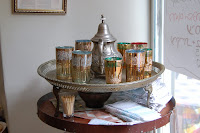by Nicholas Belzer
I have come to terms with the fact that decent Mexican food cannot be found in Jerusalem. The local version of the burrito can be spiced up with any amount of turkiye and schoog…in reality, it's all schawarma. My palate demands flaming satisfaction. My landlord, Paulos, happens to be the Ethiopian attaché to Jerusalem and I needed to my pay my rent to him at a moment of deep spice craving. I knew Paulos could give me culinary guidance.
‘Paulos, I’m needing some spice in my life’. The gambit proceeds, “Paulos, I’ve come for a culinary visa. I want to know where you go to eat Ethiopian food.” Great success, ‘the best, I will show you’. He personally escorted me to town, to a narrow alley on Ya’abetz street, which is parallel to Ben Yehudah, running right off of Jaffa Street, right before King George.
Up the green stairs of #2 Yaabetz, under the sign ‘Ethiopian Queen Restaurant’. I was greeted by Alkalet, the small, pleasant lady who runs the joint. The menu is two sided, one in english and one in…"squiggly." The theme is very Ethiopian, with red, yellow and green umbrellas hanging from the ceiling, hides of small goats strewn about and a wall-mounted flat-screen displaying various Ministers of the Ethiopian Parliament . For a moment I was distracted by the television, but the obscurity of a French flag hanging at the side of the restaurant that I noticed to my side, brought me back to where I was.
Although well-stocked with Heineken, Tuborg and Carlsberg, I pressed Alkalet to procure some genuine Ethiopian beer. Out of a secret compartment she pulled out a Meta Beer, a 5.5% proof lager in a stout brown bottle. Bitter, and full, as far as lagers go, that was right on the mark.
I noticed that the English side of the menu offers 8 meat dishes, the squiggly side offers 10. They also offer 5 vegetarian dishes, but I came here for meat and spice. I inquired about these secret dishes, it was revealed that those two were made with butter and so weren’t kosher, apparently secretly reserved for the Christian Ethiopians. The secret dishes are kitfor and gorad-gorad. The extra gorad literally serves as a warning that this dish carries double the amount of black pepper, coriander and ‘spicy’. This triumvirate of seasonings is a common theme with practically every meat dish in Ethiopian cuisine.
I chose the combination platter, so that I could try a bit of everything. Twenty minutes later, the silver platter was presented on an Injerra plate with 10 portions piled upon it. Injerra is the Ethiopian answer to the crepe, and is simultaneously the plate, the silverware and napkin. It is brown, porous, and tastes like damp matza with more brown added- after a few bites, it certainly grew on me.
First I tried kit’fo, which is minced, raw beef. It tasted soft, like a smooth black pepper residue and was not as spicy as the other meats. But the notable sensation in this dish is the blackness of the pepper, accompanied by an odd softness. Next the t’ibs, which are chunks of beef with onion, and reminded me of a stir fry. They were delicious and chunky, wrapped in with my injerra and treated like a burrito.
This brings us to the dulat. Here we get serious on the hot front, a ground beef with flaming green peppers.
Interspersed between the meat, there were piles of green lentils, red lentils, yellow stewed cabbage, purple celery, steamed orange carrots and mashed yellow chickpeas which were enjoyable by themselves. They served as light breathers between the spicy meats.
I particularly enjoyed the Meta Beer, national beer of Ethiopia, as it served the purpose of whetting the appetite, and then graciously, as an effective tonic counteracting the grease fire liable to erupt in my mouth after each handcrafted injerra dumpling.
Now as I understand it, there are eight to ten Ethiopian restaurants in Jerusalem but Ethiopian Queen boasts “The Best Authentic Ethiopian Food”. After all, this is where the Ethiopians go to eat Ethiopian. They say that Ethiopia is a land of mystery, and Ethiopian Queen is certainly a microcosm of this mysterious land. So many riddles, unanswered questions. From whence was the miniature French flag nestled between the bar? I fear I will never know. Perhaps this is the allure, that innocent novelty that is the Ethiopian Queen.












































